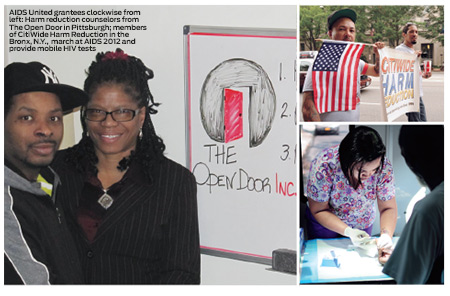
The result of a merger in 2010 between the national aids Fund (NAF) and the AIDS Action Council (AAC), AIDS United combines the grant making duties of NAF with the advocacy and policy work of AAC. Michael Kaplan became president and CEO of the Washington, DC–based group in December 2012.
He previously was executive director of the Cascade AIDS Project in Portland, Oregon. His prior experience includes several positions at the Academy for Educational Development working on domestic and international HIV/AIDS programs, as well as executive director of District 202, an LGBT youth program in Minneapolis.
Diagnosed with HIV in 1992, Kaplan shares his thoughts on how living with the virus long term has informed his professional life. He also reveals his hopes for the future of AIDS United.
Please explain what AIDS United does.
When people think of foundations, they think of groups like the Ford Foundation, which has a big bank account and sits on money. AIDS United begs with one hand and gives with the other. For the most part, every dollar that goes into our budget goes out. We’re not a traditional foundation that gives away 5 percent of its net assets every year.
Funders mostly decide the strategic vision [of their programs]. We help funders by convening consultations with them, gathering input from them and helping them review grantees. We administer the process.
An example is the Syringe Access Fund. We are proud to administer the fund, which is financed through the Elton John AIDS Foundation, the Levi Strauss Foundation, the Open Society Foundations and the Irene Diamond Fund. It’s the single largest private investment in ensuring syringe access in the United States. We manage that portfolio, but also assess how we strategically do that grant making.
On the program side, the bulk of what we do is grant making. In 2013, we’ll probably give out more than $7 million in grants. Those grants fit under different areas, such as access to care, retention in care, advocacy in the South and grant making in Puerto Rico. Each of those initiatives has technical assistance from staff along with the evaluation components often done through outside partners. We do open competition for all of our grants.
On the policy side, we have several AIDS service organizations, community health centers and other partners who pay dues to us working to help support staff in Washington, DC, who for lack of a better term would be lobbyists. They are there to work with federal legislators and the Obama administration to get the best legal and funding environment we can.
Examples of our efforts include pushing for federal funding of syringe exchange and making sure that routine HIV screenings get covered under Medicaid, as well as ensuring we have adequate funding for prevention and the Ryan White CARE Act.
What are your priorities this year?
We’ll continue to support our grant making for access to care and retention in care, evaluating models that work and finding cost-effective models. Our Retention in Care Initiative is a $4 million investment from the MAC AIDS Fund that we administer—$1 million in initial grants have already been awarded.
We’ll also continue to support advocacy, particularly in the disproportionately impacted South. We’ll especially address capacity building for stronger advocacy.
We’ve started policy discussions on how we can help community health centers and broader health systems do better HIV screening. We’re working with the Centers for Disease Control and Prevention (CDC) to reignite the conversation about HIV/AIDS among LGBT organizations, especially LGBT youth groups. With CDC funding, we’re going to have extra focus on LGBT youth organizations. We’re also gearing up for health reform implementation in 2014.
We also need to get more synergy from the NAF/AAC merger. We’ve merged the staff. We’re all in the same building, and we use the same infrastructure. What we haven’t done is activated our grantees for more engagement in our policy efforts and make sure our policy efforts are better informed through our grantees.
[We got] more of our grantees to DC for [the annual federal lobbying event] AIDSWatch [held this year in February], and we’ll be asking our grantees—90 direct and 300 indirect—to get more involved in our federal policy efforts.
How did AIDS United become a sponsor of AIDS Watch?
For the past few years, AIDSWatch had been managed by the National Association of People With AIDS (NAPWA). Most recently, it was run as a partnership between NAPWA and the Treatment Access Expansion Project (TAEP).
Since NAPWA was struggling last year [and has since gone bankrupt] and AIDS United serves as the fiscal sponsor for TAEP, we got involved with helping to run AIDSWatch. Actually, it used to be run by AAC before NAPWA.
Since we were invited to get involved two months before the event, this year we only took responsibility for marketing and logistics. Participants covered their own travel and lodging costs. My hope for 2014 is to have some scholarship funds and representation from every state across the country.
 Has living with HIV informed your work?
Has living with HIV informed your work?
I truly believe that we will not change this epidemic if we’re not working in a way that engages positive people helping to shape what those programs look like, form them and even run them. But I have a real caution around tokenistic positive involvement. HIV status alone cannot be a qualification.
Having HIV is an experience that helps me do my job better, but I couldn’t do my job now if I hadn’t done the other things in my professional life. There’s always been this careful dance in the AIDS field about engaging positive leadership, but we need to make sure it’s done in a way that helps move the field forward.
What’s it like having diabetes with HIV?
We’re getting to a point where there are a whole host of regimens and treatment options for HIV and it doesn’t have to substantially cut short a person’s life. So, in a way, it is like diabetes.
My health outcomes as a diabetic are linked to how I adhere to my daily injections and my blood glucose monitoring. Similarly, my health outcomes as a person with the virus are linked to my adherence to HIV treatment. Where the roads diverge radically is stigma.
What are some goals for AIDS United?
I want AIDS United to make a difference when it comes to stigma. Moving into 2014 to 2015, I want to see us do more to support positive organizing. When I was at Cascade AIDS Project, we did an event called Screw Stigma about getting people with HIV/AIDS doing community service. They wore T-shirts saying “Screw Stigma” while picking up litter.
It got all the local press coverage. I want AIDS United to see how we could do some grant making support for positive organizing. We’re going to start looking for more partners to help us in that effort.
It won’t be until the end of 2014 that we really realize the impact of expanded Medicaid because of the full implementation of the Affordable Care Act, so that’s a two- to three-year strategy. Similarly, while we’re doing some formative work right now around messaging for men who have sex with men (MSM), going forward we have more to do.
Why do you stay in the HIV/AIDS fight?
I’ve always been stimulated. There’s always been another challenge ahead, but something where I saw I could make an impact. More so now than ever.
To get the opportunity now at AIDS United to focus on the national level is exciting to me. As long as I have challenges, I stay engaged.






1 Comment
1 Comment